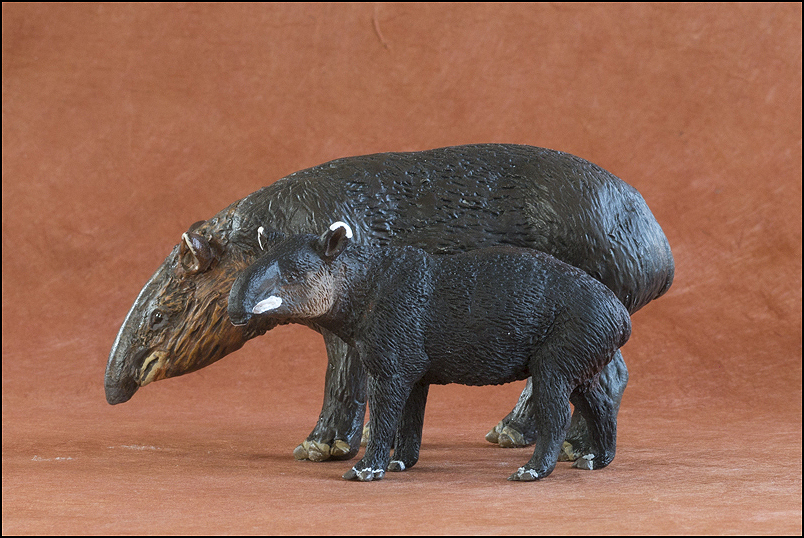Some of you may remember the first homemade Pinchaque tapir ever ? No ? The walkaround is still
HERE !Those were carefree days and a crazy macaque could name every piece of chunk a Mountain tapir... It was two years ago and it seems like centuries

.
Our friend Ana was nice enough to teach me what is really a Mountain tapir and she is absolutely right.
So here is a few pics of my Ana's mountain tapir

Ladies, gentlemen... And crocs : The context again...


The Mountain Tapir or Woolly Tapir (Tapirus pinchaque) is the smallest of the four species of tapir and is the only one to live outside of tropical rainforests in the wild.It is most easily distinguished from other tapirs by its thick woolly coat and white lips.
The species name comes from the term "La Pinchaque", an imaginary beast said to inhabit the same regions as the Mountain Tapir.
The eyes are initially blue, but change to a pale brown as the animal ages. Unlike all other species of tapir, the fur is long and woolly, especially on the underside and flanks, reaching 3.5 centimetres (1.4 in) or more in some individuals.
Adults are usually around 1.8 m in length and 0.75 to 1 m in height at the shoulder. They typically weigh between 150 and 225 kilograms and while the sexes are of similar size, females tend to be around 25 to 100 kilograms heavier than the males.
Like the other types of tapir, they have small stubby tails and long, flexible proboscises. They have four toes on each front foot and three toes on each back foot, each with large nails and supported by a padded sole. A patch of bare skin, pale pink or grey in colour, extends just above each toe.
Tapirs are herbivores, and eat a wide range of plants, including leaves, grasses, and bromeliads. In the wild, particularly common foods include lupins, Gynoxys, ferns, and umbrella plants. It also seeks out natural salt licks to satisfy its need for essential minerals.
Predators of mountain tapirs include cougars, spectacled bears, and, less commonly, jaguars.
Mountain tapirs are generally crepuscular, although they are more active during the day than other species of tapir. They sleep from roughly midnight to dawn, with an additional resting period during the hottest time of the day for a few hours after noon, and prefer to bed down in areas with heavy vegetation cover.
The Mountain Tapir is found in the cloud forests and páramo of the Eastern and Central Cordilleras mountains in Colombia, Ecuador, and the far north of Peru. The Mountain Tapir commonly lives at elevations between 2,000 and 4,300 metres.
The Mountain Tapir is the least specialised of the living species of tapir, and has changed the least since the origin of the genus in the early Miocene. Genetic studies have shown that the Mountain Tapirs diverged from its closest relative, the Brazilian Tapir, in the late Pliocene, around three million years ago. This would have been shortly after the formation of the Panamanian Isthmus, allowing the ancestors of the two living species to migrate southward from their respective points of origin in Central America. However, the modern species most likely originated in the Andes, some time after this early migration.
The Mountain Tapir is the most threatened of the four tapir species, classified as "Endangered" by the IUCN in 1996. Due to the fragmentation of its surviving range, populations may already have fallen below the level required to sustain genetic diversity, and the IUCN has predicted that there is a 20% chance that the species could be extinct as early as 2014.

There may be only 2,500 individuals left in the wild today, making it all the more difficult for scientists to study them.











 With Mr. Chunk
With Mr. Chunk 

 With the COLLECTA Baird's tapir
With the COLLECTA Baird's tapir 

